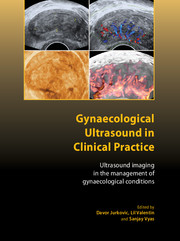 Gynaecological Ultrasound in Clinical Practice
Gynaecological Ultrasound in Clinical Practice Book contents
- Frontmatter
- Contents
- About the authors
- Abbreviations
- Preface
- 1 Ultrasound imaging in gynaecological practice
- 2 Normal pelvic anatomy
- 3 The uterus
- 4 Postmenopausal bleeding: presentation and investigation
- 5 HRT, contraceptives and other drugs affecting the endometrium
- 6 Diagnosis and management of adnexal masses
- 7 Ultrasound assessment of women with pelvic pain
- 8 Ultrasound of non-gynaecological pelvic lesions
- 9 Ultrasound imaging in reproductive medicine
- 10 Ultrasound imaging of the lower urinary tract and uterovaginal prolapse
- 11 Ultrasound and diagnosis of obstetric anal sphincter injuries
- 12 Organisation of the early pregnancy unit
- 13 Sonoembryology: ultrasound examination of early pregnancy
- 14 Diagnosis and management of miscarriage
- 15 Tubal ectopic pregnancy
- 16 Non-tubal ectopic pregnancies
- 17 Ovarian cysts in pregnancy
- Index
12 - Organisation of the early pregnancy unit
Published online by Cambridge University Press: 05 February 2014
- Frontmatter
- Contents
- About the authors
- Abbreviations
- Preface
- 1 Ultrasound imaging in gynaecological practice
- 2 Normal pelvic anatomy
- 3 The uterus
- 4 Postmenopausal bleeding: presentation and investigation
- 5 HRT, contraceptives and other drugs affecting the endometrium
- 6 Diagnosis and management of adnexal masses
- 7 Ultrasound assessment of women with pelvic pain
- 8 Ultrasound of non-gynaecological pelvic lesions
- 9 Ultrasound imaging in reproductive medicine
- 10 Ultrasound imaging of the lower urinary tract and uterovaginal prolapse
- 11 Ultrasound and diagnosis of obstetric anal sphincter injuries
- 12 Organisation of the early pregnancy unit
- 13 Sonoembryology: ultrasound examination of early pregnancy
- 14 Diagnosis and management of miscarriage
- 15 Tubal ectopic pregnancy
- 16 Non-tubal ectopic pregnancies
- 17 Ovarian cysts in pregnancy
- Index
Summary
Introduction
Early pregnancy complications are one of the most common reasons for women of reproductive age seeking medical help. Many pregnancies are complicated by pain and/or bleeding, which often causes concern because of a perceived risk of miscarriage or ectopic pregnancy. Around 40% of biochemical and clinical pregnancies may result in miscarriage and bleeding complicates around 21% of clinically detected pregnancies. There are many other symptoms which may also cause concern to pregnant women, such as hyperemesis, loss of pregnancy symptoms and gastrointestinal problems.
In the past, a woman with early pregnancy complications would first have to seek advice from her general practitioner or self refer to the accident and emergency (A&E) department in a local hospital. In A&E, early pregnancy problems would often be treated as a low priority and it was not unusual for women to spend many hours waiting to be treated. A&E departments have limited access to diagnostic and laboratory services and many women in the past had been admitted for inpatient investigations.
A significant change has occurred in the management approach to early pregnancy complications. In the past, surgery was considered necessary for both the diagnosis and treatment of early pregnancy complications. It has now been recognised that the majority of miscarriages and a significant proportion of ectopic pregnancies could be managed conservatively. Conservative management, however, requires sophisticated diagnostic facilities and a robust follow-up structure, which is not available in emergency departments.
Keywords
- Type
- Chapter
- Information
- Gynaecological Ultrasound in Clinical PracticeUltrasound Imaging in the Management of Gynaecological Conditions, pp. 133 - 142Publisher: Cambridge University PressPrint publication year: 2009


